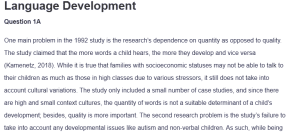Language Development
Question 1A
One main problem in the 1992 study is the research’s dependence on quantity as opposed to quality. The study claimed that the more words a child hears, the more they develop and vice versa (Kamenetz, 2018). While it is true that families with socioeconomic statuses may not be able to talk to their children as much as those in high classes due to various stressors, it still does not take into account cultural variations. The study only included a small number of case studies, and since there are high and small context cultures, the quantity of words is not a suitable determinant of a child’s development; besides, quality is more important. The second research problem is the study’s failure to take into account any developmental issues like autism and non-verbal children. As such, while being exposed to a lot of words may be beneficial, it does not take into account that even with such exposure, developmental issues can delay the child’s language development. The impact of this error is that only policies that focus on increasing word count were implemented as opposed to the quality of interactions. This means that emphasis is put on increasing verbal output and not on the engagement or meaning of an interaction. Consequently, education programs have been designed around simplistic metrics that may have overlooked deeper elements of linguistic and cognitive development.
Question 1B
One finding from the poverty and language development text centers on poverty-related stressors. These stressors usually create a harsh home environment, making it hard for parent-child interactions to occur (Newman &Newman, 2017). While this might be true, the study should not group all families struggling with poverty in one group. Many factors were not taken into consideration because the study mainly focuses on the relationship between the parent and the child to determine language development. In many cultures, children are raised not only by the parent but by the whole family, assuming that such a family is still of a lower socioeconomic status; even though the parent may not engage them, others around them do so. This is also true when a child has siblings. This study only considered the parent-child interaction, which overlooks other persons around the child.
Question 2A
One method for language described in the non-verbal article is preintentional language, whereby a child uses involuntary actions like crying to send a message that is not specific, and it is up to the caregiver to figure it out. This behavior is typical in children with autism spectrum disorder because they usually have developmental delays in regard to intentional language (Newman &Newman, 2017). The second method of language described is unconventional language, which is characterized by behaviors like tugging and crowding to get attention. This language is also common in children with autism spectrum disorder because, apart from having difficulty communicating in a conventional way, like a back-and-forth interaction, they also have difficulty with social cues or social boundaries.
Question 2B
Long before they can say their first word, children usually have a desire to communicate their needs to their caregivers (Levitt, 2006). The hindrance is that they cannot put those needs into words, so they often resort to other ways like crying, and oftentimes, their specific need will be misunderstood, leading to frustration for both the child and caregiver. However, children can use sign language to express what they need. For example, suppose a child is taught that the sign language for “hungry” is the gesture of putting a spoon in the mouth. In that case, every time they feel hungry, this will be the action they perform to communicate their needs as opposed to other easily misinterpreted actions. In addition, when a parent uses sign language and verbalizes the word for a specific action, it helps the child learn the meaning of their actions faster. Through sign language, children who cannot yet express themselves are given a voice until they are old enough to speak.
References
Kamenetz, A. (2018). Let’s stop talking about the ‘30 million word gap’. npr. https://www.npr.org/sections/ed/2018/06/01/615188051/lets-stop-talking-about-the-30-million-word-gap
Levitt. S. (2006). Toddlers find their voice in sign language. npr. https://www.npr.org/2006/05/31/5441254/toddlers-find-their-voice-in-sign-language
Newman, B. M., Newman, P. R. (2017). Development through life: A psychosocial approach. Cengage Learning.
ORDER A PLAGIARISM-FREE PAPER HERE
We’ll write everything from scratch
Question
In a post, answer the following questions:
Question 1: Read Let’s Stop Talking About The ’30 Million Word Gap’ and Chapter 6: Toddlerhood (Ages 2 to 4 Years) from Development Through Life: A Psychological Approach.
- A: In 150 words, discuss two research problems in the 1992 study that had lasting impact on education of children in poverty. Use specific examples/ citations to support your answer.
- B: In 150 words, discuss one finding from the poverty and language development from the text.
Question 2: Read My Child is Nonverbal. Anything New that might Help Him Communicate Better? and Toddlers Find their Voice in Sign Language.
- A: In 150 words, describe two methods for language described on the Autism Speaks website and relate these methods to information about ASD on p.218
- B: In 150 words, describe how sign language helps toddlers ‘find their voice’ when communicating with parents.
Language Development


